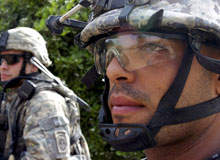
Soldiers currently operating on the front line in conflict zones including Afghanistan and Iraq are being burdened with an increasingly heavy weight to carry. As soldiers are tasked with carrying an ever-increasing list of vital equipment, the battery packs used to power this equipment increases in kind and can now amount to up to one quarter of the total weight of a soldier’s pack.
Soldiers are currently forced to carry between 45g and 75kg of equipment and under current demands battery weight can be in excess of 11kg. As a result, there is a need for new, experimental power source technology to lighten the load.
Embrace the sun
In response to this, the concept of the Solar Soldier was born. The premise of the programme is to provide a solar-powered battery pack which could be up to 50% lighter than power cells currently in use by UK soldiers, with energy collected by a combination of solar cells and thermoelectric devices. Energy created from sunlight and deviations in temperature would be stored for later use in energy cells.
Cells could be woven into a soldiers uniform, helmet or pack with studies designating choice zones highlighting the most beneficial areas to capture energy, with the shoulders providing a highly suitable location.
The programme comprises the work of 15 scientists and researchers from six universities, including the University of Glasgow, Strathclyde, Loughborough, Leeds, Brunel and Reading, and hopes to develop a complete system that can not only reduce the weight of battery cells, but distribute them more evenly across the soldier’s body.
“A lot of the weight would be distributed differently with these new power packs. It would be lighter than the batteries used as we are aiming to reduce the size of those batteries, if not replace them completely,” said University of Glasgow professor Duncan Gregory.
How well do you really know your competitors?
Access the most comprehensive Company Profiles on the market, powered by GlobalData. Save hours of research. Gain competitive edge.

Thank you!
Your download email will arrive shortly
Not ready to buy yet? Download a free sample
We are confident about the unique quality of our Company Profiles. However, we want you to make the most beneficial decision for your business, so we offer a free sample that you can download by submitting the below form
By GlobalDataRise of the Solar Soldier
Infantry units could benefit greatly from the even distribution and lighter weight that the solar soldier programme promises to provide. With a more efficient and comfortable system, effectiveness and mobility of soldiers could increase and significantly improve army operations. Theoretically, dismounted soldiers could also conduct longer operations as solar cells could provide a constant source of power, rather than having soldiers return when power cells are depleted.
The project itself has interested the UK Ministry of Defence and has since received £650,000 of funding from the MoD and the Engineering and Physical Sciences Research Council (ESPRC). Due for completion in December, a working prototype system could be developed within two years and could also be utilised in niche space applications.
Despite the premise of the project, serious doubts have been raised about the current research and how successful the Solar Soldier technology could be in a combat environment.
Is solar truly dependable?
Speaking at the 2011 Soldier Technology conference, Defence Science and Technology Laboratory (DSTL) Physical Sciences Department, Power Sources Team member Darren Browning expressed some doubts over how effective the Solar Soldier project has proven to be during initial testing. “The Solar Soldier projects needs significant investment and investigation before it can be used in missions, with testing scheduled for next year,” said Browning.
With a 62w nominal power rating, problems persist with how predictable the system is over a short timeframe, with between 30w-50w produced typically. Problems also arose when the solar panels were exposed to specific conditions more generally associated with desert-like conditions in combat zones including Afghanistan and Iraq.
The panel itself needs to be kept clean in order to work most efficiently and the prevalent dust and sand can reduce performance. The panels used also degrade in extreme heat and draw the most power from bright, cool conditions. In testing, the panels lost 20% of performance due to the climatic conditions in Cyprus in comparison to the conditions in Portland, Oregon, US, so the use of the system could largely be dictated by the location of the mission.
“The Solar Soldier project could, perhaps, have the biggest impact on bases rather than dismounted soldiers,” said Browning, stating that panels positioned in a static location to harness the greatest use of the sun could store energy in order to recharge existing battery packs when they are depleted.
Powering the future soldier
Should the continuing research into the Solar Soldier project fail to provide a consistent solution, lithium air batteries could prove to be the power source of choice for the future soldier. Browning said: “Technology in this frame is largely driven by the consumer sector, such as hybrid cars, and lithium air batteries can be optimised for power, energy, cost and safety, whilst also posing the added benefit of being completely rechargeable.”
As power systems become increasingly complex, several considerations are taken when designing a suitable power system for the future warfighter. Weight and ergonomics for the benefit of infantry troops, combined with the argument between centralised or zonal power systems could theoretically be solved by the Solar Soldier project.
As research into the Solar Soldier project continues throughout the rest of 2011, a working prototype that could solve the particular issues that have arisen is hugely anticipated. Until such a prototype is delivered the extensive use of rechargeable battery packs will continue. Should the research prove inconclusive, however, Lithium Air and reformed methanol fuel cells are waiting in the wings to provide a suitable alternative.



